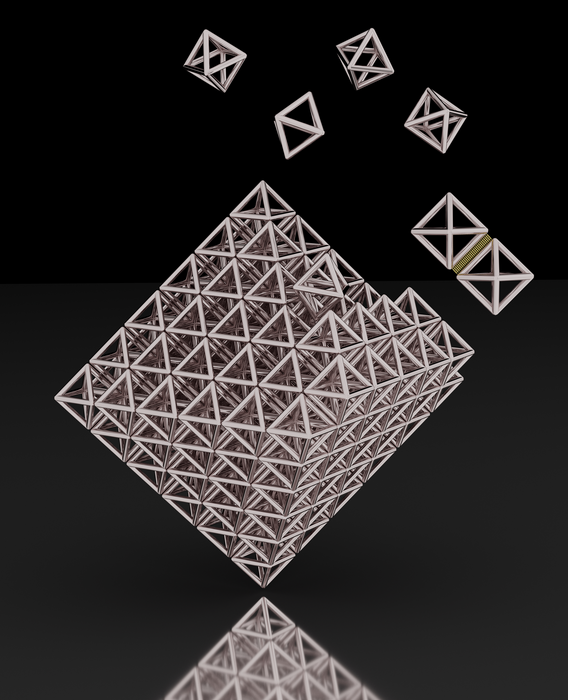Researchers from Northwestern University have made a significant advance in the way they produce exotic open-framework superlattices made of hollow metal nanoparticles.

Credit: Please credit image to Mirkin Lab / Northwestern University
Researchers from Northwestern University have made a significant advance in the way they produce exotic open-framework superlattices made of hollow metal nanoparticles.
Using tiny hollow particles termed metallic nanoframes and modifying them with appropriate sequences of DNA, the team found they could synthesize open-channel superlattices with pores ranging from 10 to 1,000 nanometers in size — sizes that have been difficult to access until now. This newfound control over porosity will enable researchers to use these colloidal crystals in molecular absorption and storage, separations, chemical sensing, catalysis and many optical applications.
The new study identifies 12 unique porous nanoparticle superlattices with control over symmetry, geometry and pore connectivity to highlight the generalizability of new design rules as a route to making novel materials.
The paper was published today (Oct. 26) in the journal Nature.
Chad A. Mirkin, the George B. Rathmann Professor of Chemistry in the Weinberg College of Arts and Sciences at Northwestern and director of the International Institute for Nanotechnology, said the new findings will have broad-ranging impacts in nanotechnology and beyond.
“We had to rethink what we knew about DNA bonding with colloidal particles,” said Mirkin, who led the research. “With these new types of hollow nanocrystals, the existing rules for crystal engineering were not adequate. Nanoparticle assembly driven by ‘edge-bonding’ allows us to access a breadth of crystalline structures that we cannot access through conventional ‘face-bonding,’ the traditional way we think of structure formation in this field. These new structures lead to new opportunities both from scientific and technological standpoints.”
A leader in nanochemistry, Mirkin is also a professor of chemical and biological engineering, biomedical engineering and materials science and engineering in the McCormick School of Engineering and a professor of medicine at Northwestern University Feinberg School of Medicine.
Mirkin’s team has been using the programmability of DNA to synthesize crystals with unusual and useful properties for over two decades; broadening the concept to include hollow particles is a big step toward a more universal approach to understanding and controlling colloidal crystal formation.
Nature uses colloidal crystals to control colors of organisms, including butterfly wings and the changeable color in the skin of a chameleon. Mirkin’s laboratory-generated structures — especially the porous ones, through which molecules, materials and even light can travel — will challenge scientists and engineers to create new devices from them.
Vinayak Dravid, the Abraham Harris Professor of Materials Science and Engineering in McCormick and an author on the paper, added that many industrial chemical processes rely on zeolites, another class of synthetic porous materials.
“There are many limitations to zeolites because these are made by physical rules that limit options,” Dravid said. “But when DNA is used as a bond, it allows for a greater diversity of structures and much larger variety of pore sizes, and thus a diverse range of properties.”
The ability to control pore size and connections between pores opens a range of potential uses. For example, the authors show that porous superlattices exhibit an interesting optical behavior called a negative refractive index not found in nature and only accessible with engineered materials.
“In this work, we discovered how open-channel superlattices can be new types of optical metamaterials that allow for a negative index of refraction,” said Koray Aydin, also an author on the paper and an associate professor of electrical and computer engineering in McCormick. “Such metamaterials enable exciting applications such as cloaking and superlensing, the imaging of super small objects with microscopy.”
The researchers are continuing to collaborate to drive the work forward.
“We need to apply these new design rules to nanoporous metallic structures made of others metals, like aluminum, and we need to scale the process,” Mirkin said. “These practical considerations are very important in the context of high-performance optical devices. Such an advance could be truly transformative.”
The paper, “Open-channel metal particle superlattices,” was funded by the Air Force Office of Scientific Research (award numbers FA9550-17-1-0348 and FA9550-16-1-0150) and the Center for Bio-Inspired Energy Science, an Energy Frontier Research Center funded by the U.S. Department of Energy, Office of Science, Basic Energy Sciences (award number DE-SC0000989).
Journal
Nature
DOI
10.1038/s41586-022-05291-y




